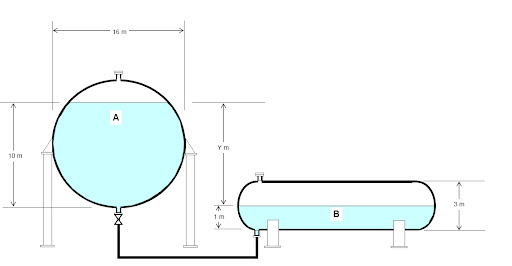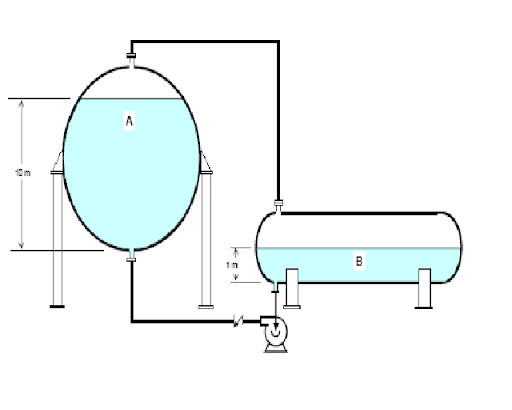QUESTION:
Hi.
I have two pressurised LPG tanks; Tank A, which is a spherical tank of capacity 2,000 m3 (About 16 m diameter) and tank B which is a horizontal tank of capacity 150 m3 (3 m dia x 23 m length). The bottom of tank A is at the same level as the centre of tank B. My question is:
1. If Tank A contains 10 m of LPG and tank B 1 m of LPG, and if the pressure in both tanks is 4 Bars, will there be flow of product from tank A to tank B?
2. If I push product into tank A from tank B via a pump, will the level of product in the tank A affect the rate of filling of the tank (e.g. level in tank A = 2 m while pressure = 3 bars & level in tank A = 10 m while pressure is still = 3 bars)?
ANSWER
1) In this scenario, both LPG storage tanks are partially filled with the same product - i.e., the LPG in both tanks has the same identical composition and properties. Therefore, the vapor pressure characteristics are the same for both tanks.
2) Both tanks are initially at the same ambient temperature and are separated from each other by a block valve (shown on the bottom of the storage sphere. There is NO VAPOR EQUALIZATION line between both tanks.
3) The height dimension "Y" is defined as:
Y = the height of the sphere liquid LPG + the height of the bullet liquid LPG + the difference between the height of the bullet LPG and 1.5 m (since the bottom of the sphere is at the same height as the centerline of the bullet).
therefore,
Y = (10) + (1) +(1.5 - 1) = 11.5 meters
4) Theoretically, if one opens the block valve the liquid in tank A will flow into tank B and eventually fill it 100%. HOWEVER, that is the theoretical result and it will also take time to accomplish - as long as both LPG tanks contain 100% IDENTICAL LPG. In real life, this is never the case. There are always variances between the LPG products and there are always
some content of inerts gases or condensables also mixed in with the LPG - albeit, in small concentrations.
5) Additionally, what also takes place is that the vapor space in Tank B is naturally compressed by the static hydraulic head pressure of the LPG in tank A. This raises the temperature of the compressed vapor and also resists the entrance of additional LPG into tank B. As tank B cools slowly (due to inefficient natual convection currents) by heat transfer to the external atmosphere, the vapor pressure decreses and more LPG from tank A enters tank B. This process continues
differenctially until eventually tank B is filled 100% with liquid LPG. HOWEVER, this is theoretical.
6) If efficient liquid transfer is desired, then a VAPOR EQUALIZATION LINE between the vapor spaces of both tanks is highly desirable and recommended.
1) In this scenario, a pump has been installed at Tank B (with a check valve) together with a vapor equalization line. The vapor equalization line facilitates the efficient pumping action because it allows the free transfer of displaced LPG vapor from Tank A to Tank B. Without the equalization line, the pumped liquid in Tank A will act as a liquid piston on the top vapor and the total developed head on the pump will be differentially increasing as the pump transfers LPG from Tank A into Tank B. This will be the case whether the pump introduces the LPG at the bottom of Tank A or at the top of Tank A.
2) Theoretically, the vapor pressure of pure LPG at the top of tank A should be equal to the pressure at the top of tank B. However, the heat of compressing the LPG vapor at the top of Tank A (assuming there is NO vapor equalization line) will increase the vapor pressure in Tank A and although it will eventually lower itself through heat transmission through the tank A walls and onto the atmosphere, this heat transfer is very slow due to its dependency on natural convection currents inside the tank and also due to the weak heat transfer coefficient of any vapor or gas.
The practical, real-life result is that the tank A vapor pressure will increase as the pump transfer LPG into that vessel IF there is no equalization line. That is why an equalization line is normally employed in tank-to-tank transfer operations.
Art Montemayor

